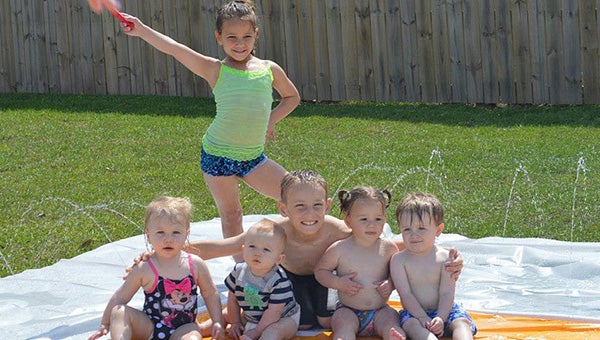Stay safe & sound in summer
Published 12:09 am Wednesday, May 20, 2015

- With summertime approaching rapidly, schools will soon be letting out, creating an abundance of free time for children to play in the water. Pictured are cousins Emri Roussel, back, and front row, from left, Collyn Becnel, Cale Becnel, Reece Roussel, Emri Roussel and Colt Vicknair enjoying some outdoor playtime. (Photos submitted)
LAPLACE — Summer is (almost) here, which means it’s time for children to break out their swimsuits, pool toys and camping gear, and time for parents to break out their sunscreen, bug repellent and Band-Aids.
Because a change in activities for children often brings about a change in safety concerns for parents, what follows is a breakdown of sun, water and bug safety information.

Sister and brother Emri and Reece Roussel hang out on the splash pad for some sibling summertime fun.
Sun safety
The heat in South Louisiana means there are many precautions caretakers must take to make sure children stay safe in the sweltering weather.
“The most important tip is to stay hydrated,” Dr. Wendi DeFrank of Rainbow Pediatrics in LaPlace said. “Even babies and toddlers need extra fluids in the heat.”
One of the most common precautions to take in the fight for sun safety is to slather on sunscreen, but sunscreen use measures vary with age.
The American Academy of Pediatrics says that for babies under 6 months old, the two main recommendations to prevent sunburn are to avoid sun exposure and to dress infants in lightweight long pants, long-sleeved shirts and brimmed hats that shade the neck to prevent sunburn.
When adequate clothing and shade are not available, the AAP recommends parents apply a minimal amount of sunscreen of at least 15 SPF to small areas, such as the baby’s face and the back of the hands.
DeFrank recommends testing a small patch of an infant’s skin before applying all over the body.
“Put a small amount on the arm or around the leg and check after 24 hours,” DeFrank said, adding parents should look for any rash or skin irritation the sunscreen may cause.
For children of all other ages, “sunscreen should be applied at least 30 minutes prior to outside time and reapplied every hour after that,” DeFrank said.
With a plethora of sunscreen options, DeFrank said she tells parents “expensive is not better,” and to purchase a lotion with an SPF of at least 30.
“Reapplication is key,” she said of sunscreen and preventing burns.
“If you do burn, as soon as you realize it, begin taking ibuprofen every six hours to reduce inflammation. You can use baking soda or vinegar in bath water to reduce stinging and burning.”
DeFrank said applying a small amount of 1 percent hydrocortisone cream to burns can also reduce inflammation and reduce blistering.
As far as when to venture outdoors for fun, DeFrank said “avoiding the hottest part of the day, 10 a.m. to 3 p.m., is best.”
She added it’s important to be careful on cloudy or windy days, because the worst burns happen when you don’t feel hot.
Water Safety
Between boating, beach trips, swimming pools and splash pads, water seems to be a mainstay in many plans for summer fun.
DeFrank said swimming lessons are a great idea, and infant swim classes are even available in some areas.
“Of course don’t stop watching your kids around water, even if they can swim,” she said, adding parents should be careful a swimming instructor isn’t pushing their child to swim in a way that will lead them to be afraid of the water.
AAP reports children over the age of 1 may be at a lower risk of drowning if they have had some formal swimming instruction, but there is no evidence swimming lessons or water survival skills courses prevent drowning in babies younger than 1 year of age.
Because of that, extreme caution should be taken with young children in the water.
The decision to enroll a child over age 1 in swimming lessons should be made by the parent based on the child’s developmental readiness and exposure to water, the AAP says.
As for boating safety, the AAP says children should wear life jackets at all times when on boats, docks or near bodies of water, and that it is important to make sure the life jacket is the right size for the child.
Bug safety
Summer vacation brings about lots of outdoor trips and playtime for children, but it can also lead to many bug bites.
The AAP cautions parents not to use scented soaps, perfumes or hair sprays on a child, as it may attract bugs.
“Bug repellents are tricky because of possible allergic reactions,” DeFrank said, adding parents should test out bug repellents on their child just like they do sunscreen.
“Also, I read that a dryer sheet pinned to your child’s clothes can repel bugs and mosquitoes.”
She said if mosquitoes do bite a child, try using 1 percent hydrocortisone for itching and swelling.
“Ant bites are really nasty,” DeFrank said of another common bug bite.
“They form sterile pustules surrounded by redness and swelling.”
She said the same rules for treatment apply as for mosquitoes, but that it’s important to resist the temptation to pop the bites, which can lead to scarring.





